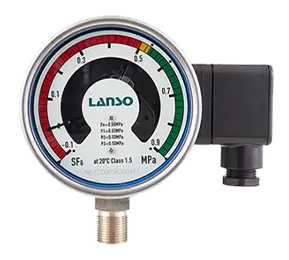SF6 (sulfur hexafluoride) gas is widely used in electrical equipment and industrial applications, but to ensure its safety and reliability, it requires quantitative analysis for leakage detection and accurate measurement of water content in SF6 gas.
SF6 Gas Density Monitor Leakage Detection
Timing of Leakage Detection
Leakage detection of SF6 gas is usually related to the installation, maintenance, or protective experiments of the equipment. After filling the equipment with SF6 gas, it is necessary to wait for at least 24 hours (or longer) before conducting the leakage detection to ensure that the gas is adequately stabilized.
Regular Pressure Inspection
SF6 Gas Density Monitor readings should be monitored during the leakage detection process. If the readings between two consecutive measurements at the same temperature differ by 0.01 to 0.03 MPa, immediate fault analysis should be conducted to identify the leakage point and take appropriate measures, while recording the results.
Emergency Measures
If the control room issues an SF6 leakage alarm, immediate emergency measures should be taken to replenish SF6 gas according to regulations. In case of severe leakage resulting in frequent gas replenishment, an immediate power outage should be requested for inspection and resolution.
Safe Operation
When conducting leakage detection work, personnel must undergo natural ventilation for 20 minutes, wear gas masks and protective clothing, and work under the supervision of a legal guardian. The filling of SF6 gas must be done according to requirements.
Using Laser Moisture Meter for Moisture Monitoring
Importance of Moisture
The moisture content in SF6 gas is one of the critical factors affecting the normal operation of equipment. Before putting the equipment into operation, especially after maintenance, moisture detection must be carried out using the Laser Moisture Meter. In general, it should be checked once a year. If the annual leakage rate exceeds 1% or the environmental humidity has significantly increased compared to the precise measurement value two years ago, a detection should also be performed.
Addressing Exceeding Standards
If excessive moisture is found, practical measures must be taken, such as using gas recovery equipment for purification treatment or repairing and replacing adsorbents inside the equipment, until the standards are met, while recording the results.
Moisture Content in Equipment
Strict gas analysis must be conducted during equipment maintenance and dismantling to ensure the discharge and treatment of used SF6 gas as it may contain harmful residues. Before treatment, the gas needs to undergo adsorbent purification to ensure the safety of maintenance personnel. The adsorbent for the recovery device should be chosen appropriately.
Quality Supervision and Management During Operation
Natural Ventilation
The equipment installation room needs regular natural ventilation to ensure the SF6 and oxygen content is within a safe range. The oxygen content should always exceed 18%.
Ventilation Standards
For equipment sites frequently accessed by personnel, there should be at least 15 minutes of ventilation per shift, with ventilation volume reaching 3 to 5 times the room capacity, and the exhaust vent should be located at the bottom of the room. For sites that are not frequently accessed, natural ventilation of at least 15 minutes is also required before entry.
Oxygen Concentration Meter
The ground layer of the equipment site should be installed with an oxygen concentration meter and SF6 concentration detector equipped with an alarm system. When the SF6 concentration reaches a dangerous level, the oxygen concentration meter will sound an alarm, and ventilation measures should be taken immediately if necessary.







